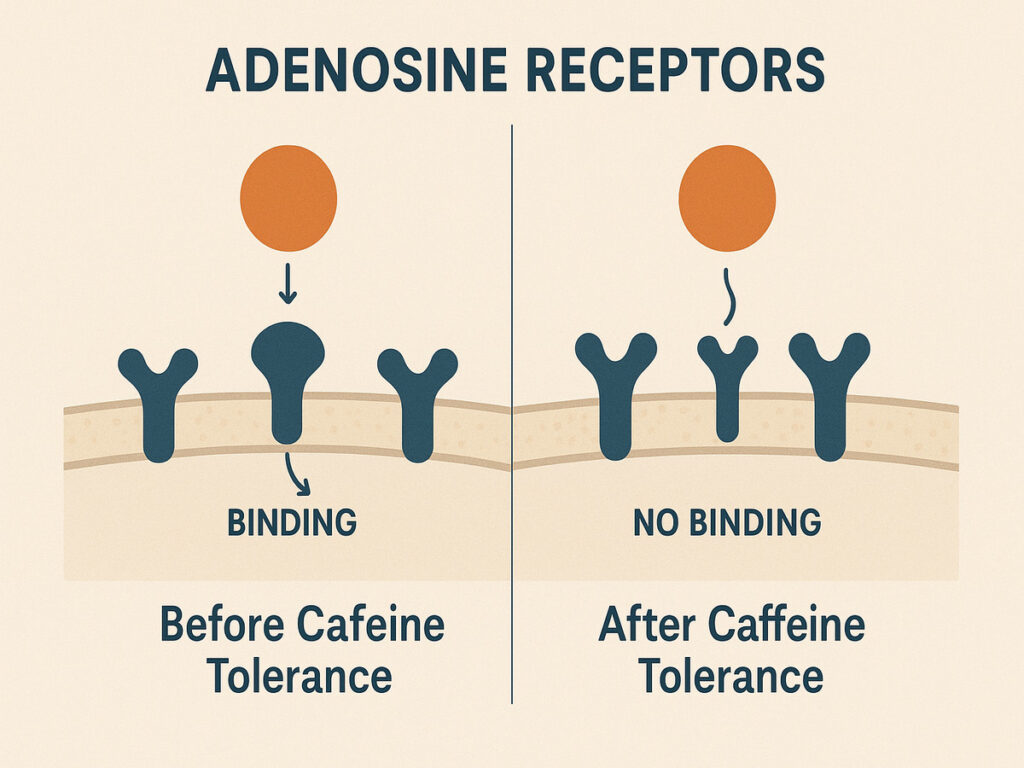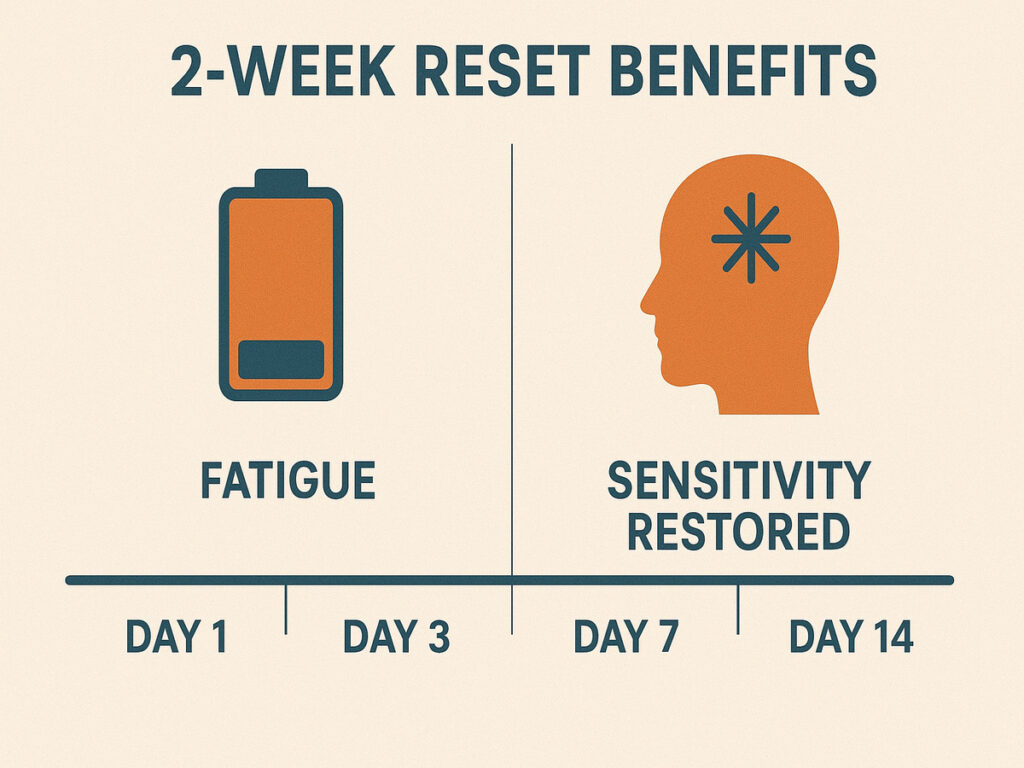Introduction: The Energy Plateau Problem
For millions of Americans, the morning cup of coffee is sacred — a ritual that jumpstarts productivity and focus.
But over time, that same brew can lose its magic. You drink it, but the buzz fades quickly, or worse, you feel tired even after caffeine.
This is a sign of caffeine tolerance — a natural adaptation that dulls your sensitivity to caffeine’s energizing effects.
Fortunately, you don’t have to quit coffee cold turkey to fix it. A proper caffeine tolerance reset can restore energy sensitivity, improve focus, and even help your body metabolize caffeine more efficiently.

What Is Caffeine Tolerance?
Caffeine works by blocking adenosine receptors in the brain — chemicals responsible for signaling fatigue.
Over time, your brain compensates by creating more adenosine receptors, meaning it takes more caffeine to achieve the same level of alertness.
The result?
You move from one cup a day to three, then four — with diminishing returns and rising irritability.
Statistic: According to a 2024 survey by the American Journal of Clinical Nutrition, 68% of U.S. adults consume caffeine daily, and nearly half report reduced energy effects over time.
How the Body Builds Resistance to Caffeine
The process of caffeine tolerance involves neurological adaptation:
- Adenosine receptor upregulation: The brain produces more receptors, reducing caffeine’s potency.
- Neurochemical desensitization: Dopamine response lessens, lowering mood lift and motivation.
- Hormonal stress: Excess caffeine elevates cortisol, worsening fatigue cycles.
- Sleep disruption: Inconsistent sleep further blunts caffeine’s natural benefits.

Signs You’ve Developed Caffeine Tolerance
- You need more coffee to feel awake
- Energy boost fades within 30–60 minutes
- Afternoon crashes feel severe
- You wake up groggy despite caffeine intake
- Headaches or irritability without caffeine
- Sleep feels less restorative
Expert Quote:
“Caffeine tolerance is less about addiction and more about adaptation. The body gets used to the stimulus — a temporary reset restores its power.”
— Dr. Marcus Hill, Neuroscientist, UCLA Center for Sleep Research
Why Most People Don’t Need to Quit Coffee Entirely
Contrary to popular belief, you don’t need to go caffeine-free to reset tolerance.
A structured taper and timing strategy helps your body resensitize to caffeine while preserving your coffee habit.
Complete withdrawal often causes rebound fatigue and irritability, making people relapse into higher caffeine doses.
Instead, a strategic caffeine deload works better for both mind and metabolism.
The Science of Resetting Caffeine Sensitivity
The goal of a reset is to recalibrate adenosine receptor balance and optimize cortisol rhythms.
This typically takes 7–14 days, depending on intake and sleep quality.
Key biological processes during a reset:
- Adenosine receptor normalization → restores natural fatigue signals
- Cortisol stabilization → reduces afternoon crashes
- Dopamine regulation → improves mood and focus naturally
- Improved sleep quality → amplifies next-day energy

Step-by-Step Caffeine Tolerance Reset Plan
Phase 1: Reduce Gradually (Days 1–3)
- Cut caffeine intake by 25–30%.
- Swap afternoon coffee for green tea or matcha (lower caffeine + L-theanine).
- Hydrate more — dehydration worsens fatigue during this stage.
Phase 2: Caffeine-Free Window (Days 4–10)
- Take a full break or switch to decaf (contains minimal caffeine).
- Sleep 8+ hours nightly to allow receptor reset.
- Support energy naturally with walks, sunlight exposure, and deep breathing.
Phase 3: Reintroduce Mindfully (Days 11–14)
- Resume caffeine only in the morning (ideally 90 minutes after waking).
- Limit to 100–150mg daily — roughly one strong cup.
- Pair with protein or fats to stabilize energy release.
Expert Insight:
“A 7–10 day caffeine deload can reset tolerance by up to 60%. Most people regain full caffeine sensitivity within two weeks.”
— Dr. Emily Rhodes, Performance Nutritionist, NASM-CPT
Nutrition & Lifestyle Support During the Reset
1. Hydration & Electrolytes
Caffeine is a mild diuretic. During a reset, focus on 3L water daily with electrolytes to prevent fatigue.
2. Magnesium & B-Vitamins
These nutrients help regulate adenosine and cortisol balance.
Foods: spinach, almonds, eggs, whole grains, avocados.
3. Sleep Optimization
Caffeine tolerance resets faster when your circadian rhythm stabilizes.
Follow consistent sleep and wake times; avoid blue light at night.
4. Physical Activity
Light cardio or walking enhances blood flow, helping the body flush caffeine metabolites faster.

Caffeine Alternatives That Support Recovery
| Alternative | Key Benefit | Notes |
|---|---|---|
| Matcha Tea | Gentle energy + focus | Contains L-theanine for calm alertness |
| Yerba Mate | Smooth stimulation | Rich in antioxidants |
| Chicory Coffee | Caffeine-free | Supports gut health |
| Golden Milk (Turmeric Latte) | Anti-inflammatory | Ideal for evenings |
| Green Smoothies | Nutrient boost | Supports adrenal recovery |
Expert Insights & Research Findings
“People don’t realize caffeine tolerance is reversible. With proper recovery and nutrition, you can get your energy sensitivity back — no need to quit forever.”
— Dr. Andrew Patel, Integrative Health Expert, Johns Hopkins University
“Caffeine isn’t the enemy. Chronic overuse is. Cycling it correctly makes your brain more responsive over time.”
— Dr. Karen Ellis, Human Performance Researcher, University of Colorado
Statistic: A 2025 Sleep Foundation Report found that adults who cycled caffeine monthly reported 23% higher sustained energy levels compared to daily users.
Actionable Reset Checklist
☑ Reduce caffeine by 25% in first 3 days
☑ Stay hydrated (3L water/day minimum)
☑ Take a full caffeine break for 7–10 days
☑ Sleep 7–9 hours nightly
☑ Support with magnesium-rich foods
☑ Reintroduce caffeine slowly (morning only)
☑ Track mood, energy, and focus
Common Myths & FAQ
Q1: Is quitting caffeine necessary to reset tolerance?
A: No. A partial break or taper can effectively restore sensitivity for most people.
Q2: Will I get withdrawal headaches?
A: Possibly during days 2–4. Hydration, magnesium, and light exercise help reduce them.
Q3: How long before coffee feels strong again?
A: Typically within 10–14 days of reduced or paused intake.
Q4: Can caffeine resets improve sleep?
A: Yes. By normalizing adenosine function, many users report deeper, more restorative sleep.
Authoritative Resources
- National library of Medicine – Caffeine Effects & Tolerance
- Sleep Foundation – How Caffeine Affects Sleep
- Harvard Health Publishing – Caffeine and the Brain
Internal Reading Links (Fitoast Articles)
- Metabolic Damage Recovery: The Science of Repairing Your Body After Dieting Too Hard
- Post-Workout Inflammation: How to Reduce Muscle Swelling and Recover Faster Naturally
Conclusion & Call-to-Action
Resetting your caffeine tolerance doesn’t mean giving up coffee — it means using it smarter.
By giving your body time to recalibrate, you’ll rediscover what true, clean energy feels like again.
Next Step: Try the 14-day caffeine reset plan this month and track your energy levels.
When you reintroduce that first morning cup, you’ll notice the difference — sustained focus, no crash, and renewed productivity.

